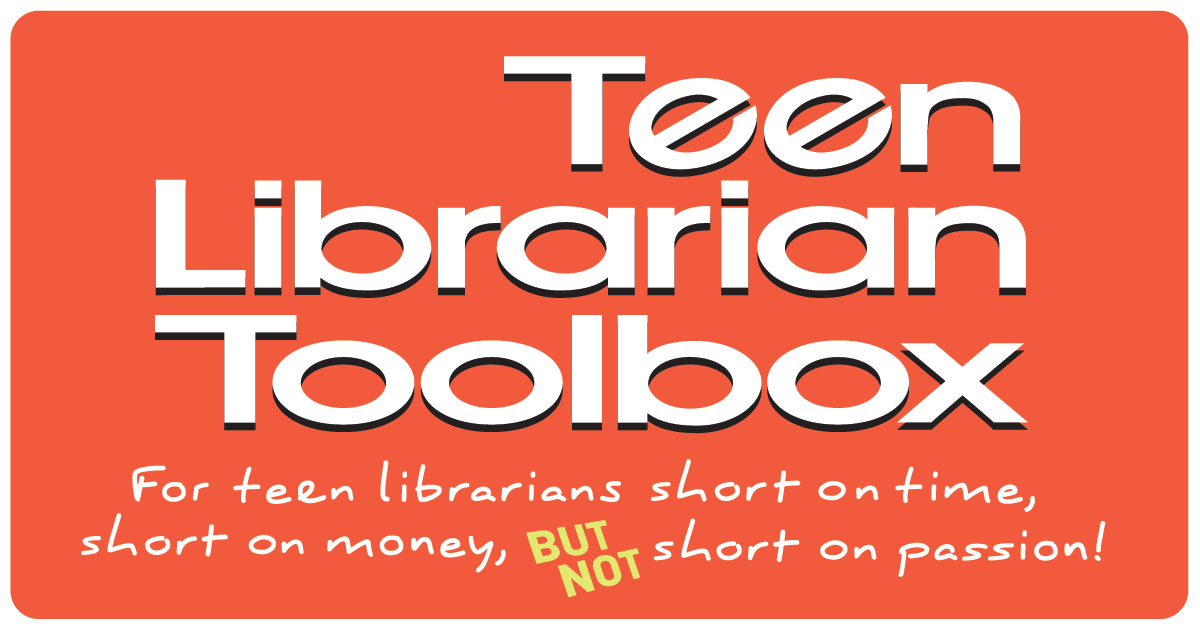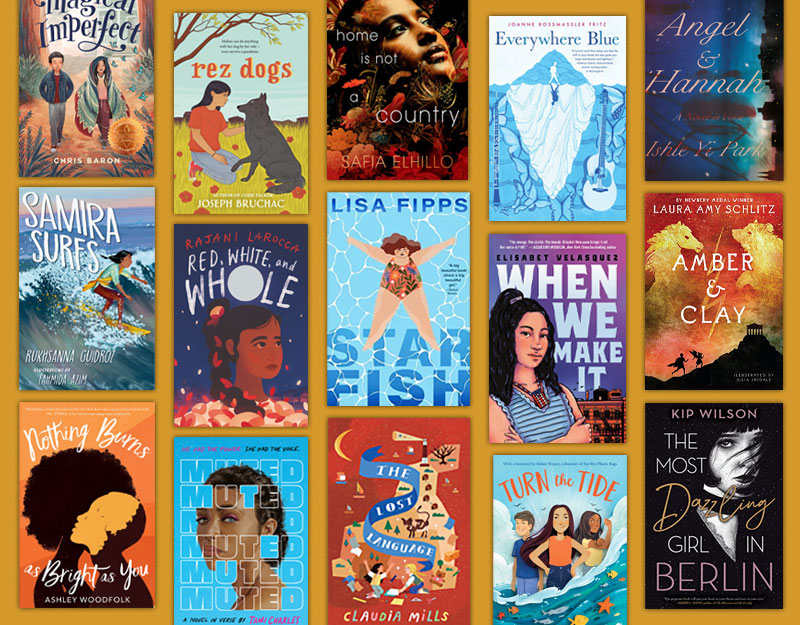National School Climate Survey results about LGBT students’ experiences in school
 GLSEN, the Gay, Lesbian and Straight Education Network, released its biennial National School Climate Survey, which documents the experiences of LGBTQ students from across the country, in late October. If these statistics shock you, you clearly haven’t spent much time talking to gay students or hanging out in a high school or a middle school. The good news is that things have improved slightly from their 2011 survey. The bad news is that it’s still really ugly out there.
GLSEN, the Gay, Lesbian and Straight Education Network, released its biennial National School Climate Survey, which documents the experiences of LGBTQ students from across the country, in late October. If these statistics shock you, you clearly haven’t spent much time talking to gay students or hanging out in a high school or a middle school. The good news is that things have improved slightly from their 2011 survey. The bad news is that it’s still really ugly out there.
168 page report (which is available as a PDF and as an hour-long webinar) looks at discrimination, harassment, assault, biased language, school resources and support, and more, and examines how these factors affect educational performance, safety, and mental health of LGBT teens. The report is filled with statistics, charts, and graphs that drive home the point that LGBT students face a lot of opposition at school and frequently don’t feel safe or supported. Being knowledgeable of their potential struggles and understanding where they (and you!) can go to find useful resources (books, websites, helplines, etc) is a major step in the right direction. As GLSEN reports, “The survey has consistently indicated that a safer school climate directly relates to the availability of LGBT school-based resources and support, including Gay-Straight Alliances, inclusive curriculum, supportive school staff, and comprehensive anti-bullying policies.” This report should be required reading for anyone who works with teenagers.
ADVERTISEMENT
ADVERTISEMENT
Findings of the 2013 National School Climate Survey include: 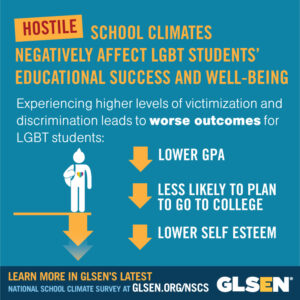
Anti-LGBT Remarks at School
• 71.4% of LGBT students heard “gay” used in a negative way (e.g., “that’s so gay”) frequently or often at school, and 90.8% reported that they felt distressed because of this language
• 64.5% heard other homophobic remarks (e.g., “dyke” or “faggot”) frequently or often.
• 56.4% heard negative remarks about gender expression (not acting “masculine enough” or “feminine enough”) frequently or often.
• 51.4% of students reported hearing homophobic remarks from their teachers or other school staff, and 55.5% of students reported hearing negative remarks about gender expression from teachers or other school staff.
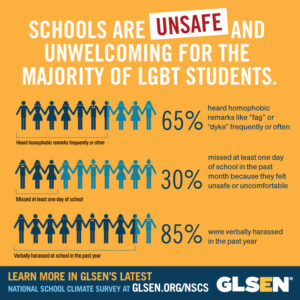 School Safety, Harassment, and Assault at School
School Safety, Harassment, and Assault at School
• 55.5% felt unsafe because of their sexual orientation, and 37.8% because of their gender expression.
• 74.1% were verbally harassed (e.g., called names or threatened) in the past year because of their sexual orientation, and 55.2% because of their gender expression.
• 36.2% were physically harassed (e.g., pushed or shoved) in the past year because of their sexual orientation, and 22.7% because of their gender expression.
• 16.5% were physically assaulted (e.g., punched, kicked, injured with a weapon) in the past year because of their sexual orientation, and 11.4% because of their gender expression.
• 49.0% of LGBT students experienced electronic harassment in the past year (via text messages or postings on Facebook), often known as cyberbullying.
The high incidence of harassment and assault is exacerbated by school staff who rarely, if ever, intervene on behalf of LGBT students.
• 56.7% of students who were harassed or assaulted in school did not report the incident to school staff, most often believing little to no action would be taken or the situation could become worse if reported.
• 61.6% of the students who did report an incident said that school staff did nothing in response.
The report goes on to discuss: 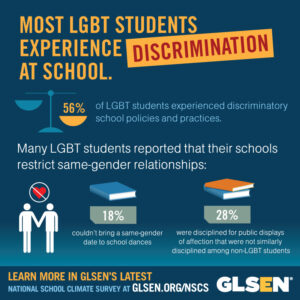
*absenteeism (“Many LGBT students avoid classes or miss entire days of school rather than face a hostile school climate. An unsafe school environment denies these students their right to an education.”)
*academic achievement (“School safety affects student success. Experiencing victimization in school hinders LGBT students’ academic success and educational aspirations.”)
*psychological well-being (“Experiences of harassment and assault in school are related to poorer psychological well-being for LGBT students.”).
Additionally, it looks at discriminatory policies, discriminatory discipline, restrictions, and prohibitions regarding public displays of affection, attending dances, forming a GSA, writing about LGBT topics, etc. It breaks the data down by race, ethnicity, school type, location, region, and more.
GLSEN offers many recommendations for turning these statistics around, such as giving students more access to LGBT-related information (literature, history, etc), forming GSA groups, providing professional development to increase the number of supportive teachers and staff, ensuring school policies are not discriminatory, having anti-bullying and harassment policies that make it clear that they provide safety for LGBT students, and teaching an inclusive curriculum.
Previously at TLT:
ADVERTISEMENT
ADVERTISEMENT
Check out my previous post GLBTQ YA Resources for Building a Collection and Supporting Teens, which compiles articles and websites for great suggestions on books to add to your library collections and how to support GLBTQ youth.
Also check out:
The Human Rights Campaign’s Welcoming Schools Project, which “is one of the few LGBT and gender-inclusive programs in the country that has a K-5 focus with resources to help elementary schools and educators address bias-based bullying—including anti-LGBT slurs and gender put-downs.”
HRC’s Time to Thrive conference (Februrary 13-15, 2015, in Portland, Oregon, “where nearly 1,000 educators, social workers, professional counselors and other youth-serving professionals are expected to attend.” You might remember that it was at this conference earlier this year that actress Ellen Page gave a moving coming out speech)
From their site: GLSEN, the Gay, Lesbian & Straight Education Network, is the leading national education organization focused on ensuring safe and affirming schools for all students. Established in 1990, GLSEN envisions a world in which every child learns to respect and accept all people, regardless of sexual orientation or gender identity/expression. GLSEN seeks to develop school climates where difference is valued for the positive contribution it makes to creating a more vibrant and diverse community. For information on GLSEN’s research, educational resources, public policy advocacy, student organizing programs and educator training initiatives, visit www.glsen.org.
Filed under: GLBTQ, GLBTQ issues, GLBTQ Support
About Amanda MacGregor
Amanda MacGregor works in an elementary library, loves dogs, and can be found on Twitter @CiteSomething.
ADVERTISEMENT
ADVERTISEMENT
SLJ Blog Network
2024 Books from Pura Belpré Winners
In Memorium: The Great Étienne Delessert Passes Away
Winnie-The-Pooh | Review
Parsing Religion in Public Schools
ADVERTISEMENT

